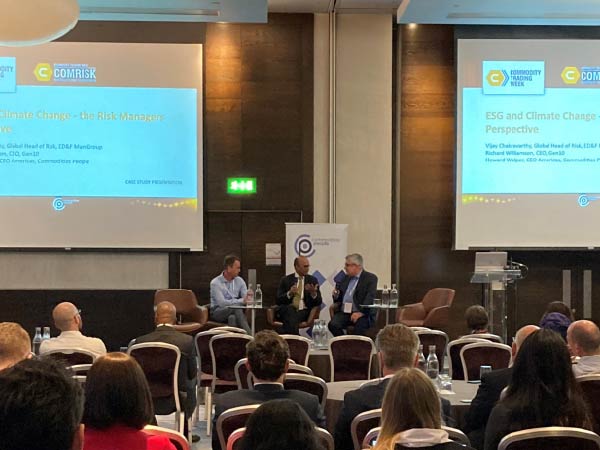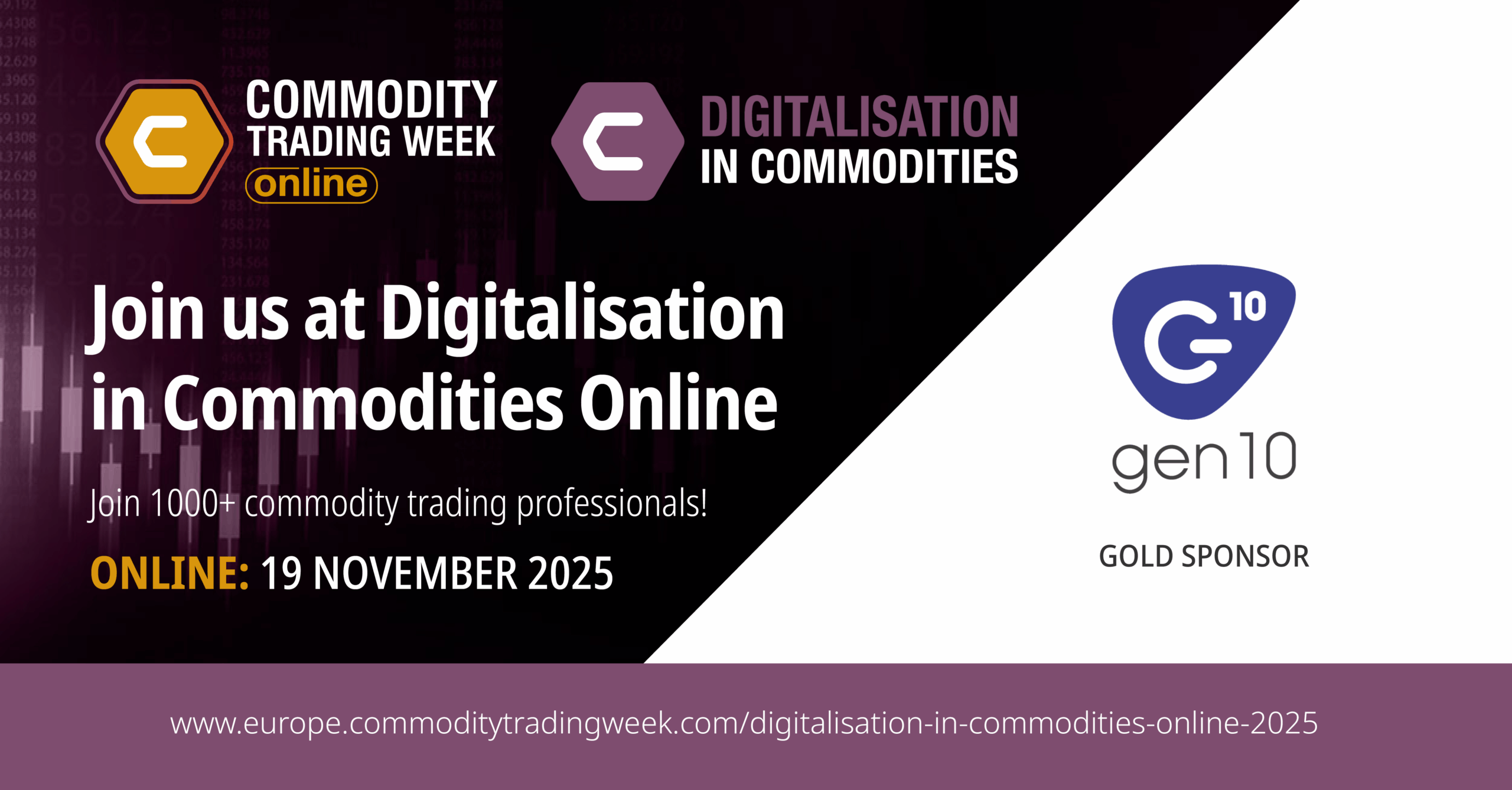In April, Commodity Trading Week returned to London for a 2 day in-person event across 5 separate conferences. The conferences covered every aspect of commodity trading, from risk management and technology to supply chain and trade finance. It also included panel discussions featuring Richard Williamson, Gen10 CEO, and Bruce Tozer, from Gen10’s Advisory Board.
Today we are looking at some of the common themes that were discussed in a wide range of sessions across the different conferences, as well as what they mean for Commodity Management technology.
The first thing we noticed was a change in the problems people were looking to solve when talking to us in the exhibition hall. Gen10 recently launched NetZero OS to help commodity organisations manage carbon offsetting projects and credits, and whilst we had many productive conversations about Commodity Management as well, it was definitely carbon management that was on most stand visitors’ minds.
We’re in volatile times
Everybody in commodities knows that we are seeing high volatility now. And as one plenary speaker pointed out, it is one of those rare occasions when people outside the industry are also aware, with commodities and shipping making headlines in many national newspapers. With shipping delays and shortages of staple foods and energy commodities affecting everyday life, we can expect to see more state intervention in securing essentials, as well as shortages keeping prices high. Although there are also warnings of potential upcoming recessions in several major economies.
Whilst traders generally like some volatility, there were comments that the current environment is presenting more of a challenge. The Covid-19 pandemic and the invasion of Ukraine both created many risks for commodity traders. These include price and liquidity risk, which also increase credit risk, and an increased risk of fraud.
Of course, hedging can be used to mitigate price risk, but with higher volatility, it is more important than ever to ensure hedges accurately reflect your real-time position. To do this, risk managers need to understand the impact of adverse effects on your organisation as quickly as possible. They also need to be updated as live positions change; waiting for weekly or even daily reports introduces an unnecessary level of risk in the era of real-time integration and when good Commodity Management systems are used to manage trading, not simply report on it after the fact.
And standard checks for transactional risk can help mitigate fraud risk. For example, ensuring onboarding and know your counterparty policies are both up-to-date and being followed can reduce a large part of this risk. Commodity Management systems can help with both onboarding and verification, and with counterparty management such as alerting your team to upcoming document expiry dates, credit usage and payment history.
Other simple checks were recommended at Commodity Trading Week, including actions such as calling the shipping line to ensure goods have been loaded before releasing payment. Again, a good Commodity Management system should be able to support your people in these activities. Flexible workflows can be changed to reflect your processes and ensure that each stage is followed before the next action is undertaken so new policies are not accidentally circumvented.
Decarbonisation and the energy transition
The impact that decarbonisation will have on commodities is still an unknown, but most sessions either discussed or touched on it. Commodities are a large contributor to climate change in their use of energy, both directly and in inputs such as fertiliser, as well as in shipping. And despite the question over whether fossil fuels will be able to change their current image, they will still be needed during the energy transition in the years to come.
Much of the uncertainty arises from the global nature of the challenge; legislation is currently patchy, and as with all ESG regulations, varies in different jurisdictions. And because policy is still continually changing, it is difficult for those investing in green technologies to understand their potential returns.
However, the energy transition is happening, and consumers are not the only stakeholders. Investors expect companies to share their values, and with current staffing shortages, company purpose can be a critical recruitment and retention tool.
Carbon markets were also discussed, as many organisations are either establishing carbon trading desks or taking a closer look at improving their own carbon impact. Advice on trading the transition included being careful with hedging, keeping the bigger market picture in mind and being careful of greenwashing. The reputational damage of getting caught offsetting carbon emissions badly is a major risk, so it is important to be clear about the types of any offsets you purchase and understand their unique features, such as whether they are regulated, their age, and be aware of unusually low prices.
Once again, technology can help. Carbon offsetting projects are not standardised and can deliver many different benefits in addition to carbon removal/reduction, details of which could be lost if the market demands uniform credits. But if you have the processes and systems to measure and record these assays, the contracts do not need to be standardised.
And technology can also provide lessons in how to implement carbon processes in your organisation. With uncertainty about how the market will develop and new systems still evolving, carbon management is an iterative process. Several speakers advised following an agile process, as good technology providers do, of implementing the best systems that are available to you now and being prepared to adapt as you go along, rather than waiting for a “perfect” solution that may not arrive.
Technology and CTRM
CTRM and Commodity Management are usually on the DigiCom and ComRisk agendas, and this year was no different. The general consensus was that since the Covid-19 pandemic, senior managers have changed their thinking in terms of IT investment, and discussions are now framed around the pain of not investing, rather than potential ROI.
The importance of getting people involved early in an implementation and providing ongoing training and support after the go-live was highlighted. As were opportunities to improve the selection process. Many commented on problems with RFPs, and the consensus was that they have not changed to keep up with modern technology and requirements. The advice on improving the selection process was for clients to do more to refine their actual needs based on their goals before they start the selection process, and to consider other options such as a proof of concept.
The other major discussion of technology implementations was around monolithic vs modular systems. Several panels discussed how projects that involve one large-scale implementation often go wrong, and often have too many requirements. However, modular implementations or projects that involve several specific apps, such as a Gen10 implementation plan, allow clients to break the project down into a series of smaller implementations. This creates less disruption and creates faster results for each team, making it easier to generate buy-in too.
There was even one session devoted to interoperability, a concept Gen10 have built all our products to support. Interoperability is all about sharing data and working together across different technology platforms, even from different providers, in a commodity management ecosystem. This allows clients to use the technologies that solve a particular problem, reconfigure systems and add new functionality as their business evolves. When your systems connect automatically in this way, your people can focus on what really matters to the business.
Commodity Management is a core business requirement
As Commodity Trading Week has shown, commodity industries are facing many different challenges in the years ahead, but there is also a great deal of excitement around solving these challenges, and confidence in our ability to do so. Technology plays a significant role in helping commodity firms rise to new challenges, covering everything from volatility to opening up carbon markets.
Commodity Management technology is easier than ever to implement and can be supplemented by a range of modular solutions designed to interact with each other so that your business can select the best solution to each challenge you are facing. These solutions are designed to work together to empower your teams and create a technology ecosystem that truly works for your business.
Not sure how Commodity Management could be an improvement on your existing CTRM? Get in touch today and we’ll be happy to discuss how it could be applied in your particular use case.



